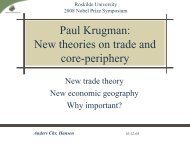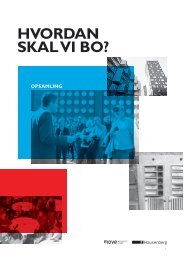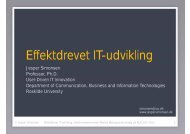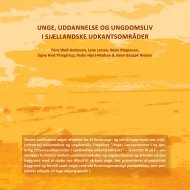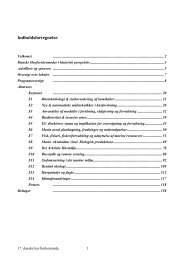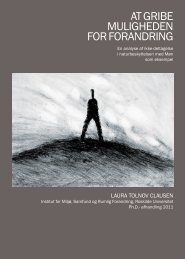The dual system of VET in Denmark - Roskilde Universitet
The dual system of VET in Denmark - Roskilde Universitet
The dual system of VET in Denmark - Roskilde Universitet
You also want an ePaper? Increase the reach of your titles
YUMPU automatically turns print PDFs into web optimized ePapers that Google loves.
Paper for the Nordyrk conference Åland June 2011<strong>The</strong> paper is based on two reports on hybrid qualifications <strong>in</strong> <strong>Denmark</strong> available onhttp://hq-lll.eu/ produced <strong>in</strong> the EU research project hybrid qualifications 2009-11.A revised and comprehensive summary <strong>of</strong> the results for <strong>Denmark</strong> will appear <strong>in</strong> the bookpublished late <strong>in</strong> 2011:Thomas Deiss<strong>in</strong>ger & Josef Aff & Alison Fuller &Christian H. Jørgensen (Eds.) 2011:Hybrid Qualifications – structural and political issues <strong>in</strong> the context <strong>of</strong> European <strong>VET</strong> policyBern, Zürich, New York, London. Peter Lang Publ..Christian Helms Jørgensen, <strong>Roskilde</strong> University 2011<strong>The</strong> <strong>dual</strong> <strong>system</strong> <strong>of</strong> <strong>VET</strong> <strong>in</strong> <strong>Denmark</strong>– a ‘bl<strong>in</strong>d alley’ on the road to Higher EducationSeparation <strong>of</strong> students and qualificationsIn <strong>Denmark</strong> the Basic School up to grade 9 or 10 is a compulsory comprehensive education primarily<strong>in</strong> public schools. When young people at the age <strong>of</strong> 16 or 17 complete the Basic School, they have todecide which way to go. All except a few percent cont<strong>in</strong>ue <strong>in</strong>to post compulsory education at highersecondary level – at grade 10 to 12 called ‘youth education’ <strong>in</strong> <strong>Denmark</strong>. <strong>The</strong> pathways at this levelare divided <strong>in</strong> two tracks: general education and vocational education and tra<strong>in</strong><strong>in</strong>g (<strong>VET</strong>). <strong>The</strong> aimsand purposes <strong>of</strong> the two tracks are different. Vocational education has a purpose <strong>of</strong> develop<strong>in</strong>g relevantqualifications that are recognised on the labour market and give access to employment. <strong>The</strong>ma<strong>in</strong> purpose <strong>of</strong> general education is to develop qualifications that are recognised by the <strong>in</strong>stitutions<strong>of</strong> higher education and prepare for studies at the tertiary level. In addition some <strong>of</strong> the generalobjectives <strong>of</strong> the two tracks <strong>of</strong> education are similar: they should support the student’s personaldevelopment and their democratic engagement <strong>in</strong> society and prepare for lifelong learn<strong>in</strong>g.<strong>The</strong> division between the two tracks is quite pr<strong>of</strong>ound and concerns the social recruitment, thelearn<strong>in</strong>g culture, the legal framework and the form <strong>of</strong> governance <strong>of</strong> education. <strong>The</strong> two types <strong>of</strong>education also have separate <strong>in</strong>stitutions locally: on the one hand the Gymnasiums and on the otherhand the vocational colleges that are <strong>of</strong>ten located separately <strong>in</strong> Technical, Bus<strong>in</strong>ess & Commercial,Agricultural and Health Care & Social Work colleges. An exception here is the Vocational Gymnasiumsthat are located <strong>in</strong> the legal and adm<strong>in</strong>istrative framework <strong>of</strong> the vocational colleges and <strong>of</strong>tenalso physically <strong>in</strong> this context.In this paper ‘hybrid qualifications’ is a term used to describe qualifications that <strong>in</strong>tegrate vocationaland general qualification and give access to higher education as well as to the occupational labourmarkets <strong>of</strong> skilled workers. Hybrid qualifications are <strong>in</strong>terest<strong>in</strong>g s<strong>in</strong>ce they provide an opportunity togo across the vocational- general divide that characterises the Danish educational <strong>system</strong>. <strong>The</strong> name
Vocational Gymnasium could <strong>in</strong>dicate that the Vocational Gymnasium is an <strong>in</strong>stitution that provideshybrid qualifications. This though, is not the case, as the vocational Gymnasium is purely schoolbased, and it does not award the certified qualifications that give access to the skilled labour market.<strong>The</strong> Vocational Gymnasium is accord<strong>in</strong>g to the latest reform <strong>of</strong> 2005 part <strong>of</strong> the unified <strong>system</strong> <strong>of</strong>‘gymnasium programs’, whose ma<strong>in</strong> purpose is to prepare for higher education. More correctly thisprogram could be termed ‘vocationally oriented Gymnasium’ as its aim is the vocation programs <strong>of</strong>higher education like eng<strong>in</strong>eer<strong>in</strong>g and bus<strong>in</strong>ess economics.<strong>The</strong> Danish educational <strong>system</strong> does not fit clearly <strong>in</strong> the common ideal types as def<strong>in</strong>ed by Gre<strong>in</strong>ert(1999) or Ashton (2004). Some comparative studies, like Andreas Walther (2006) and Beatrix Niemeyer(2007), <strong>in</strong>clude the Danish <strong>system</strong> <strong>in</strong> a common Nordic model. This model is characterized asbe<strong>in</strong>g school based and non selective and l<strong>in</strong>ked to the egalitarian, social-democratic type <strong>of</strong> universalwelfare regime (Esp<strong>in</strong>g-Andersen 1990). This categorisation is relevant with respect to compulsoryeducation and higher education, but much less so for higher secondary education, where Norwayand Sweden have more unified <strong>system</strong>s than <strong>Denmark</strong>. <strong>The</strong> Danish <strong>system</strong> on this level is differentby be<strong>in</strong>g selective, because <strong>of</strong> the separation between the vocational and general tracks. Whilethe Danish educational <strong>system</strong> generally has been more decentralised than the other Scand<strong>in</strong>aviancountries (Telhaug a.o. 2004), the <strong>dual</strong> <strong>system</strong> <strong>of</strong> vocational education has been more centralisedwith little <strong>in</strong>volvement <strong>of</strong> local or regional authorities (Ol<strong>of</strong>son 2008). In comparison with the otherNordic countries <strong>Denmark</strong> has the most ‘classic’ form <strong>of</strong> <strong>dual</strong> <strong>system</strong> <strong>of</strong> vocational education that isseparate from general education and similar <strong>in</strong> many ways to the German model. However, the <strong>VET</strong><strong>system</strong> <strong>in</strong> <strong>Denmark</strong> is more school based than <strong>in</strong> Germany as the programs typically start with onehalf or one year learn<strong>in</strong>g <strong>in</strong> vocational college before enter<strong>in</strong>g a work based tra<strong>in</strong><strong>in</strong>g agreement.Figure 1.Transitions <strong>in</strong> the Danish educational <strong>system</strong>17Adult education1514MasterBachelorShortMaster levelDiploma levelHigher educationFurther Adulteducation VVU4%1253%General educationPreparation forhigher education10% doublequalifications5% │ 18%38%<strong>VET</strong> - Dual <strong>system</strong>Preparation forthe labour marketHigher Prep.Exam. hf9-10Years <strong>of</strong>education56% Basic school 40%9 – 10th gradeF<strong>in</strong>al rates <strong>of</strong> completion 25 years after leav<strong>in</strong>g basic school Percentages <strong>of</strong> a youth cohort <strong>in</strong> 2006hybrid qualifications Source UNI-C 2008GeneralAdult EducationFVU – AVU
Access to higher education through adult educationS<strong>in</strong>ce the 1960es a comprehensive <strong>system</strong> <strong>of</strong> adult education has been established <strong>in</strong> <strong>Denmark</strong> parallelto the ord<strong>in</strong>ary educational <strong>system</strong>. This <strong>in</strong>cluded first a wide range <strong>of</strong> shorter vocationalcourses (Labour Market Tra<strong>in</strong><strong>in</strong>g, AMU) f<strong>in</strong>anced and governed through a corporatist form <strong>of</strong> collaborationbetween the state and the labour market partners. A National Council for Adult VocationalEducation and Tra<strong>in</strong><strong>in</strong>g (REVE) has an advisory role to the M<strong>in</strong>ister <strong>of</strong> Education, and <strong>in</strong> addition11 cont<strong>in</strong>u<strong>in</strong>g tra<strong>in</strong><strong>in</strong>g and education committees have responsibility for specific sectors <strong>of</strong> thelabour market. <strong>The</strong> <strong>system</strong> <strong>of</strong> Labour Market Tra<strong>in</strong><strong>in</strong>g (AMU) was from the start clearly separatefrom the basic <strong>dual</strong> System <strong>of</strong> <strong>VET</strong> and belonged under the M<strong>in</strong>istry <strong>of</strong> Employment, but moved <strong>in</strong>1995 to the M<strong>in</strong>istry <strong>of</strong> Education. This separation had to do with the division and rivalry betweenthe unions <strong>of</strong> the skilled and the unskilled workers who are organised <strong>in</strong> separate unions. For the last15 years the two <strong>system</strong>s <strong>of</strong> C<strong>VET</strong> and I<strong>VET</strong> have <strong>in</strong>creas<strong>in</strong>gly become <strong>in</strong>tegrated legally and <strong>in</strong>stitutionally.New opportunities have been established for unskilled and semiskilled workers with relevantwork experience to get supplementary school based education to become skilled.Another measure <strong>in</strong> this direction has been an expansion <strong>of</strong> the opportunities for adult apprenticeships.This <strong>in</strong>itiative has been driven by a comb<strong>in</strong>ed effort <strong>of</strong> the government and the General WorkersUnion (‘3F’) ambitions to lift their members from the status <strong>of</strong> unskilled to skilled. This policy hasdeveloped <strong>in</strong> response to numerous forecasts <strong>of</strong> a strong decl<strong>in</strong>e <strong>in</strong> the future requirement for unskilledlabour. This has resulted <strong>in</strong> a strong <strong>in</strong>terest <strong>in</strong> giv<strong>in</strong>g un- and semiskilled workers better accessto education and tra<strong>in</strong><strong>in</strong>g to become skilled. It is remarkable that no similar <strong>in</strong>itiatives havetaken to give skilled workers access to higher education. In l<strong>in</strong>e with this there has been little <strong>in</strong>terest<strong>in</strong> provid<strong>in</strong>g programs for hybrid qualifications. This is <strong>in</strong> contrast to the political <strong>in</strong>terest at theEuropean level <strong>in</strong> the provision <strong>of</strong> pathways for progression from <strong>in</strong>itial <strong>VET</strong> to higher education(CEDEFOP 2008; Dunkel 2009). It is remarkable that this has been no significant issue <strong>in</strong> <strong>Denmark</strong>,s<strong>in</strong>ce the country has a strong tradition for adult and further education and the educational <strong>system</strong>provides very good opportunities for people to return to education later on <strong>in</strong> life (Dieckh<strong>of</strong>f 2008).One reason for the lack <strong>of</strong> <strong>in</strong>terest <strong>in</strong> hybrid qualifications and progression routes from <strong>VET</strong> to highereducation lies <strong>in</strong> the governance <strong>of</strong> <strong>VET</strong>. <strong>The</strong> corporatist form <strong>of</strong> governance <strong>of</strong> the <strong>dual</strong> Systemmeans that the unions have a strong pr<strong>of</strong>essional orientation that <strong>in</strong>cludes <strong>in</strong>terest <strong>in</strong> the upgrad<strong>in</strong>g<strong>of</strong> occupational skillsand improvement <strong>of</strong>the opportunities forfurther education andtra<strong>in</strong><strong>in</strong>g <strong>of</strong> their members(Hyman 2001). Dueto the occupationalbasis <strong>of</strong> these organizationsthis pr<strong>of</strong>essionalorientation has not<strong>in</strong>cluded <strong>in</strong>terests <strong>in</strong>general qualificationsand access to highereducation. Yet the educationalprograms for14%12%10%8%6%4%2%0%Figure 2: Share <strong>of</strong> students who progress to HigherEducation3 years after complet<strong>in</strong>g a vocational education <strong>in</strong> 2004All programs Bus<strong>in</strong>ess Construction ServiceVocational program completed <strong>in</strong> 2004Level <strong>of</strong>tertiaryeducationstarted at<strong>in</strong> 2004-07MasterBach.ShortCHJ calculations for HQ on DST dataset
adult <strong>in</strong> <strong>Denmark</strong> <strong>of</strong>fers opportunities for achiev<strong>in</strong>g higher education entrance qualifications, especiallythe hf program.Pathways from <strong>VET</strong> to the polytechnicsSkilled workers have historically had some l<strong>in</strong>ks to the polytechnic universities. Dur<strong>in</strong>g the earlyyears <strong>of</strong> the <strong>in</strong>dustrial revolution <strong>in</strong> the late 1800th century Danish skilled workers went to the German‘Technische Hochschulen’ (Institutes <strong>of</strong> Technology) for further study, s<strong>in</strong>ce this was not yetpossible <strong>in</strong> <strong>Denmark</strong>. Later, as the eng<strong>in</strong>eer<strong>in</strong>g <strong>in</strong>stitutions expanded, these were also accessed byskilled workers. With the post-war expansion <strong>of</strong> higher education the <strong>in</strong>creas<strong>in</strong>g requirements <strong>of</strong>general and theoretical knowledge made the direct access difficult for skilled workers. In 1961 a oneyearpreparation courses was established as an opportunity for skilled workers who wanted to progressto study eng<strong>in</strong>eer<strong>in</strong>g at a higher level, typically <strong>in</strong> the 3½ year ‘practical’ type <strong>of</strong> education foreng<strong>in</strong>eers (‘Diplom-<strong>in</strong>geniør’) with specialization <strong>in</strong> chemistry, mach<strong>in</strong>ery, construction, etc. This hasfor decades been a well-known pathway for a small but stable number <strong>of</strong> people with a vocationaleducation to cont<strong>in</strong>ue to higher education. <strong>The</strong>re are signs that this pattern <strong>of</strong> progression from <strong>VET</strong>to higher education has weakened due to the <strong>in</strong>creas<strong>in</strong>g share <strong>of</strong> young people who go to a Gymnasium.Especially the number <strong>of</strong> students <strong>in</strong> the ‘Diplom-<strong>in</strong>geniør’ program (Bachelor level) has beenreduced to half size it had <strong>in</strong> 1990 (VTU 2005). In the Technical Universities the share <strong>of</strong> eng<strong>in</strong>eer<strong>in</strong>gstudents who have a vocational education before start<strong>in</strong>g has decl<strong>in</strong>ed (A4 2009). <strong>The</strong> share <strong>of</strong> studentwho has a ‘craft’ background at the ‘Diplom-<strong>in</strong>geniør’ study has decreased from over 30% <strong>in</strong>1980 to 7% <strong>in</strong> 2004 (VTU 2005). At the same time the share <strong>of</strong> students from the Vocational Gymnasium(htx) has <strong>in</strong>creased.Policies for Hybrid QualificationsEuropean countries have pursued different strategies to improve the esteem <strong>of</strong> vocational educationcompared to general education (Raffe a.o. 1998). A common categorisation proposed by Lasonen &Young (1998) def<strong>in</strong>es four strategies for parity <strong>of</strong> esteem. <strong>The</strong>se are: (1) vocational enhancement; (2)mutual enrichment; (3) l<strong>in</strong>kages; and (4) unification. <strong>The</strong> dom<strong>in</strong>ant strategy <strong>of</strong> the Danish context isthe first, vocational enhancement, which attempts to ma<strong>in</strong>ta<strong>in</strong> the separation <strong>of</strong> the two tracks, butupgrade the quality <strong>of</strong> the curriculum, teachers’ qualifications or relations with the labour market.Most <strong>of</strong> the political parties <strong>in</strong> <strong>Denmark</strong> and the dom<strong>in</strong>ant labour market organizations are <strong>in</strong> favour<strong>of</strong> ma<strong>in</strong>ta<strong>in</strong><strong>in</strong>g vocational education as a separate <strong>system</strong>. <strong>The</strong> reasons are the efficiency <strong>of</strong> this <strong>system</strong>concern<strong>in</strong>g successful transition from school to work, high employment rates and high flexibilityon the labour market (Jørgensen 2008). But ma<strong>in</strong>ta<strong>in</strong><strong>in</strong>g the division <strong>in</strong> two separate tracks and adivision <strong>of</strong> students based on their atta<strong>in</strong>ment <strong>in</strong> primary and lower secondary education also hasnegative sides. Track<strong>in</strong>g entails a social selection <strong>of</strong> students accord<strong>in</strong>g to the socio-economic status<strong>of</strong> their parents. Track<strong>in</strong>g thus tends to reduce equality <strong>of</strong> educational opportunities <strong>in</strong> the transitionfrom school to work (Hanushek and Wößmann 2006; Müller & Gangl 2003). Children from familieswith poor educational background more <strong>of</strong>ten are sorted <strong>in</strong>to vocational education, even when theireducational atta<strong>in</strong>ments equals the atta<strong>in</strong>ment <strong>of</strong> children from families with more educational resources(Andersen 2005; Hansen 1997). This negative effect <strong>of</strong> track<strong>in</strong>g has historically been a reasonfor the labour movement and the Social Democratic Party to oppose track<strong>in</strong>g and favour reforms<strong>in</strong> the direction <strong>of</strong> a comprehensive school.
Table 1: Separate qualifications <strong>in</strong> Danish higher secondary educationTrack ► General education Vocational educationStructureInstitutionsTypes <strong>of</strong> qualificationsSchool-/workbasedLengthGovernanceFund<strong>in</strong>gAccess/recruitmentLearn<strong>in</strong>g cultureTeachersShare <strong>of</strong> a agegroup complet<strong>in</strong>gAcademic qualifications that give access tohigher education:- Universities- University colleges4 programs:• Traditional academic Gymnasium, stx• Bus<strong>in</strong>ess oriented Gymnasium, hhx• Technically oriented Gymnasium, htx• Higher Preparatory Exam, hfGymnasium (stx)Vocational colleges (hhx and htx)Adult Education Centre (hf)Only school-based(plus opportunities for a few weeks <strong>of</strong> workplacement <strong>in</strong> Vocational Gymnasium)3 years generally (stx/hhx/htx)2 years for Higher Prep. Exam (hf)State governed comb<strong>in</strong>ed with <strong>in</strong>stitutionalautonomy. Gymnasiums are becom<strong>in</strong>g <strong>in</strong>dependent(‘state freehold’)State fund<strong>in</strong>g <strong>of</strong> schools and students grants(for students over 18 years). Free tuition.Restricted admission:Specific subjects <strong>in</strong> Basic School Gradepo<strong>in</strong>t average requiredValu<strong>in</strong>g the correctness <strong>of</strong> codified knowledge.Structured by school /academic subjectsand discipl<strong>in</strong>es, but <strong>in</strong>creas<strong>in</strong>gly also<strong>in</strong>terdiscipl<strong>in</strong>ary project work.Teachers with academic education (masterdegree plus further pedagogic tra<strong>in</strong><strong>in</strong>g)Academic track: 53%With doublequalifications: 10%Vocational qualifications that give access to theskilled labour market :- Union membership- Unemployment benefits• 12 basic courses (½ - 2 year)• 125 ma<strong>in</strong> programs withadditional specializationsVocational colleges:- Technical, bus<strong>in</strong>ess, agricultural and care &service work.Alternat<strong>in</strong>g (<strong>dual</strong>) programs:1/3 school-based, 2/3 work-basedFull time school-based programs available as a‘special measure’.3 – 4 years generally- A few longer: 5 years- A few shorter: 1½ - 2 yearsCorporatist self-governanceVocational colleges are <strong>in</strong>dependent <strong>in</strong>stitutions(‘state freehold’)State fund<strong>in</strong>g <strong>of</strong> colleges. Companies pay wagesto apprentices when tra<strong>in</strong>ed <strong>in</strong> companies.Companies share expenses to wages dur<strong>in</strong>gschool-based learn<strong>in</strong>g.Generally free admission.In some programs a tra<strong>in</strong><strong>in</strong>g agreement with acompany is required.In some numerous clauses.Valu<strong>in</strong>g the usefulness <strong>of</strong> vocational knowledgeand skills.Structured by the work tasks and the collaboration<strong>of</strong> journeymen and apprentices.Ma<strong>in</strong>ly teachers with vocational /pr<strong>of</strong>essionalbackground and labour market experience.Pr<strong>of</strong>essional teachers teach <strong>in</strong> some schoolsubject.Vocational track: 38%
<strong>The</strong> term<strong>in</strong>ation <strong>of</strong> track<strong>in</strong>g was accomplished <strong>in</strong> <strong>Denmark</strong> with respect to primary and lower secondaryeducation <strong>in</strong> the early 1970es. At that time a major reform was under way <strong>in</strong> vocational educationas the traditional apprenticeship had run <strong>in</strong>to crisis due to fall<strong>in</strong>g numbers <strong>of</strong> applicants. So itwas natural also to question track<strong>in</strong>g at the higher secondary level <strong>of</strong> education. This was a high time<strong>of</strong> democratic reforms <strong>of</strong> the educational <strong>system</strong> follow<strong>in</strong>g the student unrest <strong>of</strong> the late 1960es.Apprentices played a central role <strong>in</strong> the early waves <strong>of</strong> the student movements with sizeable demonstrationsaround the country aga<strong>in</strong>st the traditional apprenticeship (‘Master apprenticeship’). Consequentlydemands were raised for a unified and untracked <strong>system</strong> <strong>of</strong> higher secondary educationespecially <strong>in</strong> part <strong>of</strong> the labour movement and on the Left W<strong>in</strong>g <strong>in</strong> Parliament. It is relevant to take alook back at these historical encounters, s<strong>in</strong>ce this period <strong>in</strong> theories <strong>of</strong> path dependency can beconsidered as a ‘critical juncture’ (<strong>The</strong>len 2004; Mahoney 2000). <strong>The</strong> outcome <strong>of</strong> the struggles, negotiationsand the coalitions formed <strong>in</strong> this period has set the direction for the <strong>in</strong>stitutional trajectory<strong>in</strong> the follow<strong>in</strong>g decades till today.2. Methods and data <strong>of</strong> study<strong>The</strong> study conducted has an exploratory character and has the aim <strong>of</strong> mapp<strong>in</strong>g the perceptions, attitudesand values <strong>of</strong> the stakeholders (teachers, learners, employers, policy-makers) <strong>in</strong> relation tohybrid qualifications. In addition the <strong>in</strong>tention is to exam<strong>in</strong>e to what extent there are best practiceapproaches and what policy implications can be formulated as a consequence.<strong>The</strong> selection <strong>of</strong> persons for the 23 <strong>in</strong>terviews <strong>in</strong> this study has been made with an <strong>in</strong>tention to coverthe key stakeholders <strong>in</strong> the field. This <strong>in</strong>cludes two civil servants <strong>in</strong> the m<strong>in</strong>istry <strong>of</strong> education withgood knowledge <strong>of</strong> the political process lead<strong>in</strong>g to the <strong>in</strong>troduction <strong>of</strong> the new hybrid qualificationsprogramme – one from each department <strong>in</strong>volved. It also <strong>in</strong>cludes five representatives from thelabour market partners who have a key role <strong>in</strong> the governance structures <strong>of</strong> <strong>VET</strong>: two from employersassociations and two from trade union federations and one from a vocational teacher union. Atthe level <strong>of</strong> educational <strong>in</strong>stitutions we have selected six persons from higher education <strong>in</strong>stitutions,all from the polytechnic and bus<strong>in</strong>ess <strong>in</strong>stitution that are dest<strong>in</strong>ations for students from the <strong>dual</strong> <strong>VET</strong><strong>system</strong>. From the vocational colleges we have selected four persons from technical as well as bus<strong>in</strong>essprograms and from <strong>in</strong>stitutions with experiences <strong>of</strong> hybrid qualification programs. We selectedpersons with hand on experience <strong>of</strong> the experimental hybrid programme EUD-HTX rather than managerswho would have more general op<strong>in</strong>ions the hybrid program. Lastly we have selected four students,three for a group <strong>in</strong>terview and one for a s<strong>in</strong>gle person <strong>in</strong>terview. <strong>The</strong>y have all completed avocational education 3-5 years ago and two have later progressed to higher education. In sum the<strong>in</strong>terviews <strong>in</strong>cluded the follow<strong>in</strong>g persons:• 2 persons <strong>in</strong> the M<strong>in</strong>istry <strong>of</strong> Education• 5 persons from the labour market partners• 6 persons from higher education <strong>in</strong>stitutions• 4 persons from vocational colleges• 2 persons from tra<strong>in</strong><strong>in</strong>g companies <strong>in</strong>volved <strong>in</strong> the hybrid programme (EUD-HTX)• 4 former vocational students – <strong>of</strong> these 2 have cont<strong>in</strong>ued to higher educationWe have promised the <strong>in</strong>terviewpersons to preserve their anonymity <strong>in</strong> order to make them speakmore freely on issues that are politically sensitive. In the list <strong>of</strong> <strong>in</strong>terview persons at the back <strong>of</strong> this
eport only the position or title <strong>of</strong> the <strong>in</strong>terview person and the name <strong>of</strong> the <strong>in</strong>stitutions and organisationsappear. Separate <strong>in</strong>terview guides were prepared for each group <strong>of</strong> <strong>in</strong>terview persons andthe <strong>in</strong>terviews were ma<strong>in</strong>ly conducted <strong>in</strong> a structured form, though with some open questions toexplore op<strong>in</strong>ions and attitudes <strong>of</strong> the <strong>in</strong>terview persons. <strong>The</strong> open questions led us to new themes,which we have explored <strong>in</strong> some <strong>of</strong> the subsequent <strong>in</strong>terviews. <strong>The</strong> <strong>in</strong>terviews were recorded, transcribedand analysed thematically guided by the research <strong>in</strong>terests <strong>of</strong> this project.Eux: a new programme for hybrid qualificationsFollow<strong>in</strong>g a major reform <strong>of</strong> vocational education <strong>in</strong> 2000 new opportunities for acquir<strong>in</strong>g hybridqualifications <strong>in</strong> the <strong>dual</strong> <strong>system</strong> were <strong>in</strong>troduced. Students were <strong>of</strong>fered additional academic subjectsto be completed dur<strong>in</strong>g the ord<strong>in</strong>ary vocational programs. But very few students have takenadvantage <strong>of</strong> this opportunity. One reason is that it is not very economically attractive for the collegesto <strong>of</strong>fer these subjects, s<strong>in</strong>ce it is difficult to get together a sufficient number <strong>of</strong> students <strong>in</strong>each subject to organise a class. Another reason is that students <strong>of</strong>ten don’t want take additionalsubjects, because then they will be separated from their ord<strong>in</strong>ary classmates.A new <strong>in</strong>itiative for hybrid qualifications was launched <strong>in</strong> two vocational colleges <strong>in</strong> 2005 with a developmentalprogramme that comb<strong>in</strong>ed vocational and general education. It was the so called 5 year‘EUD-HTX program’ that made it possible to become a skilled carpenter, automation-technician or<strong>in</strong>dustrial technician and at the same time get access to higher education. <strong>The</strong> first students fromthis programme completed <strong>in</strong> the summer <strong>of</strong> 2010. <strong>The</strong> evaluation <strong>of</strong> the developmental programmehas shown that the duration <strong>of</strong> five years was too long to attract any substantial number <strong>of</strong>students. It was not clear for students what the advantages were <strong>of</strong> the programme when compar<strong>in</strong>git to tak<strong>in</strong>g double education. <strong>The</strong> students would only save ½ - 1 year study time when choos<strong>in</strong>gthe developmental programme compared to complet<strong>in</strong>g the programs consecutively, one after theother.A revised <strong>in</strong>itiative thus was launched <strong>in</strong> 2010 by the pass<strong>in</strong>g <strong>of</strong> a law on the so called ‘EUX program’.<strong>The</strong> EUX represent a programme for full hybrid qualifications <strong>in</strong> the strong sense, which means thatthe two types <strong>of</strong> qualifications are transmitted <strong>in</strong> an <strong>in</strong>tegrated form <strong>in</strong> a s<strong>in</strong>gle program. <strong>The</strong> experi-
ence from the developmental programme (‘EUD-HTX’) showed that to succeed the programme hadto cope with some serious challenges. <strong>The</strong>se challenges relate to the <strong>in</strong>stitutional separation <strong>of</strong> thetwo types <strong>of</strong> qualifications that we have described exist <strong>in</strong> the Danish educational <strong>system</strong>. <strong>The</strong> EUXprogramme has only started <strong>in</strong> a limited number <strong>of</strong> occupational areas <strong>in</strong> the build<strong>in</strong>g trades such ascarpenters and bricklayers, but is under preparation <strong>in</strong> many other areas, such as electricians, datatechniciansand <strong>in</strong>dustrial technicians. Our <strong>in</strong>terviews have <strong>in</strong>vestigated the motives and <strong>in</strong>terestsbeh<strong>in</strong>d the new programme and tried to get an assessment <strong>of</strong> its viability from the perspective <strong>of</strong>the key stakeholders at all levels from the m<strong>in</strong>istry <strong>of</strong> education to the students.Key issues <strong>in</strong> relation to the hybrid programmeOur <strong>in</strong>terviews have <strong>in</strong>dicated that at a structural level the educational pathways from the <strong>dual</strong> <strong>system</strong><strong>of</strong> <strong>VET</strong> to higher education have become more difficult over time. One <strong>in</strong>terviewperson fromthe M<strong>in</strong>istry <strong>of</strong> Education expressed it <strong>in</strong> this way, that ‘the hole through has become narrowed’. Thisnarrow<strong>in</strong>g <strong>of</strong> the progression routes from the <strong>dual</strong> <strong>VET</strong> to higher education is expla<strong>in</strong>ed by a number<strong>of</strong> reasons. One reason is that the entrance requirements have been raised at the most frequentlyused dest<strong>in</strong>ation programs at tertiary level for vocational students. Only a few (like the sub-bachelorprogramme for electric <strong>in</strong>stallation contractor) is still accessible directly from a programme <strong>in</strong> the<strong>dual</strong> <strong>system</strong>. Other tertiary programs have been reformed and aligned with the general entrancerequirements to higher education, which is an exam at the level <strong>of</strong> the Gymnasium. Another reasonis that there is an <strong>in</strong>creas<strong>in</strong>g share <strong>of</strong> students with low level <strong>of</strong> general qualifications <strong>in</strong> the vocationalprograms. This is due to the fact that practically all young people today do progress from basicschool <strong>in</strong>to post-compulsory education. But some <strong>of</strong> these students are not driven by positive motivationand ambitions, but are forced to enrol by the active labour market policy that especially aimsat young people. S<strong>in</strong>ce their level <strong>of</strong> qualifications hardly even is enough to make them complete avocational program, they certa<strong>in</strong>ly don’t qualify for entrance <strong>in</strong>to higher education. Furthermore the<strong>in</strong>troduction and expansion <strong>of</strong> the programs <strong>of</strong> the vocational gymnasium has pulled a substantialshare <strong>of</strong> the academically strong students out <strong>of</strong> the <strong>dual</strong> <strong>system</strong> <strong>in</strong>to these programs. In additionthe technical gymnasium has gra<strong>dual</strong>ly been separated from the <strong>dual</strong> <strong>system</strong> and become more <strong>in</strong>tegrated<strong>in</strong>to the other programs <strong>of</strong> general education. In sum the division <strong>of</strong> the <strong>dual</strong> <strong>system</strong> <strong>of</strong> <strong>VET</strong>and higher education has been fortified over time, and the strong <strong>in</strong>crease <strong>in</strong> the share <strong>of</strong> youngpeople who progress <strong>in</strong>to higher education has passed round the <strong>dual</strong> <strong>system</strong>. As a consequence the<strong>dual</strong> <strong>system</strong> <strong>in</strong>creas<strong>in</strong>gly emerges as a ‘bl<strong>in</strong>d alley’ <strong>in</strong> the educational <strong>system</strong>.Our <strong>in</strong>terviews have confirmed that very few students <strong>in</strong> the <strong>dual</strong> <strong>system</strong> have taken advantage <strong>of</strong>the opportunities for choos<strong>in</strong>g additional general subjects that were <strong>in</strong>troduced by a major reform <strong>of</strong><strong>VET</strong> <strong>in</strong> year 2000. <strong>The</strong> reform failed <strong>in</strong> this respect the <strong>in</strong>tentions <strong>of</strong> widen<strong>in</strong>g the progression routesfrom <strong>VET</strong> to higher education. On the contrary some years later there have been adjustments <strong>in</strong> thevocational programs with the purpose <strong>of</strong> limit<strong>in</strong>g the amount <strong>of</strong> general content <strong>of</strong> the programs <strong>in</strong>order to reduce dropout rates. This is because dropout is assumed to be related to many ‘at-risk’students´ aversions to learn<strong>in</strong>g abstract and bookish knowledge <strong>in</strong> academic forms <strong>of</strong> education.This means that the <strong>dual</strong> <strong>system</strong> <strong>of</strong> vocational education has moved further apart from the gymnasiums.In order to attract more determ<strong>in</strong>ed and academically strong students to the vocational programssome colleges <strong>in</strong> 2005 launched as an experiment the hybrid programme EUD-HTX <strong>in</strong> collaborationwith the M<strong>in</strong>istry <strong>of</strong> Education. <strong>The</strong> first students completed <strong>in</strong> the summer <strong>of</strong> 2010, and the as-
sessments <strong>of</strong> the experiences were generally positive. <strong>The</strong> students who enrolled <strong>in</strong> the hybrid programmewere assessed by the vocational colleges to be more ambitious and motivated than students<strong>in</strong> the ord<strong>in</strong>ary vocational programs. <strong>The</strong> employers <strong>of</strong> the tra<strong>in</strong><strong>in</strong>g companies had positivejudgements <strong>of</strong> the students, as they could perform more advanced tasks and work more <strong>in</strong>dependently.But the colleges found that it was difficult to recruit a sufficient number <strong>of</strong> students and thatthe length <strong>of</strong> five years was a barrier to reach<strong>in</strong>g a greater number <strong>of</strong> students.<strong>The</strong> experiences from this developmental programme (EUD-HTX) <strong>in</strong>spired the pass<strong>in</strong>g <strong>of</strong> a legalframework for the <strong>in</strong>troduction <strong>of</strong> the new hybrid program, the EUX <strong>in</strong> 2010. <strong>The</strong> <strong>in</strong>tentions <strong>of</strong> theprogramme were similar to the developmental program, but the length was shorter and the levelwas to be lower <strong>in</strong> some subjects. Our <strong>in</strong>terviews have revealed a number <strong>of</strong> political and pedagogicaldilemmas to be handled <strong>in</strong> the plann<strong>in</strong>g and organisation <strong>of</strong> this hybrid program. We will analysego further <strong>in</strong>to these dilemmas <strong>in</strong> the follow<strong>in</strong>g, but first we will take a look at the reasons thestakeholders gave for support<strong>in</strong>g the <strong>in</strong>troduction <strong>of</strong> a new hybrid program.Reasons for <strong>in</strong>troduc<strong>in</strong>g a new hybrid programmeAmong the stakeholders we found some variation <strong>in</strong> the reasons given for support<strong>in</strong>g the new hybridprogram. <strong>The</strong> follow<strong>in</strong>g reasons were given by the <strong>in</strong>terviewpersons or were expressed <strong>in</strong>documents relat<strong>in</strong>g to the stakeholders:• To provide better opportunities for students <strong>in</strong> the vocational programs to progress to highereducation.• To <strong>in</strong>crease the recruitment <strong>of</strong> more academically strong students to the vocational collegesand the <strong>dual</strong> <strong>system</strong> <strong>of</strong> <strong>VET</strong>• To <strong>in</strong>crease the esteem <strong>of</strong> vocational education by <strong>in</strong>clud<strong>in</strong>g more advanced programs• To reduce ‘bl<strong>in</strong>d alleys’ <strong>in</strong> the educational <strong>system</strong> and to provide more educational choices forstudents <strong>in</strong> <strong>VET</strong>.• To reduce the costs <strong>of</strong> double education and to improve the overall efficiency <strong>of</strong> the <strong>system</strong> by<strong>in</strong>creas<strong>in</strong>g the permeability <strong>in</strong> the educational <strong>system</strong> from higher secondary vocational educationto higher education.• To establish a shorter, recognised and <strong>in</strong>tegrated hybrid programme for the students who otherwisewould take more irregular pathways to achieve double education.• To counteract and diversify the ‘academic drift’ <strong>in</strong> the direction <strong>of</strong> the gymnasiums by <strong>of</strong>fer<strong>in</strong>g anew hybrid programme <strong>in</strong> the vocational colleges.• To widen the recruitment to the tertiary level <strong>of</strong> education and reduce the social <strong>in</strong>equality <strong>in</strong>access to higher education by establish<strong>in</strong>g a new pathway that goes across the divide betweenthe two tracks <strong>in</strong> higher secondary education.• Educate highly valued employees with hybrid qualifications to work on the boundaries betweenthe development and production departments. Hybrid qualifications are expected to l<strong>in</strong>k thecommunities <strong>of</strong> the craftsmen and skilled workers with research and development and theplann<strong>in</strong>g, sales, costumer and market<strong>in</strong>g departments. Build<strong>in</strong>g eng<strong>in</strong>eers with experiences <strong>of</strong>the practice <strong>of</strong> the craft were mentioned as highly valued on the labour market.
Target groups for the hybrid programmeS<strong>in</strong>ce the early 1990es educational reforms with neoliberal <strong>in</strong>spiration have sought to reduce directstate regulation and replace it with an educational market. To achieve this education <strong>in</strong>stitutionshave been granted higher degrees <strong>of</strong> autonomy and have been encouraged to develop new programsand compete for students. <strong>The</strong> <strong>in</strong>creased competition for students has put vocational collegesunder pressure, given the academic drift <strong>of</strong> young people and the persistent <strong>in</strong>crease <strong>in</strong> the <strong>in</strong>take <strong>of</strong>students <strong>in</strong> the Gymnasiums. S<strong>in</strong>ce the 1980es there has been a doubl<strong>in</strong>g <strong>of</strong> the share <strong>of</strong> a youthcohort that enters higher education. This massive <strong>in</strong>crease has passed round the vocational collegesand <strong>in</strong>creas<strong>in</strong>gly positioned these as ‘bl<strong>in</strong>d alleys’ <strong>of</strong> the educational <strong>system</strong>.<strong>The</strong> <strong>in</strong>terviewpersons emphasized especially the consequences <strong>of</strong> the expansion <strong>of</strong> the vocationalgymnasiums which have attracted many <strong>of</strong> the ambitious students, who would earlier have gone tovocational education. In addition they underscore the importance <strong>of</strong> attract<strong>in</strong>g to the new EUX programmeambitious students from the other higher secondary programs and not just to provide anew pathway for students, who would go to vocational education anyway.<strong>The</strong> vocational colleges don’t expect it will be easy to attract a greater number <strong>of</strong> students to thehybrid program. At the same time they agree that it is very important not admit students, who don’thave the necessary qualifications to complete the program. <strong>The</strong> colleges describe the hybrid programmeas very hard and demand<strong>in</strong>g. <strong>The</strong> colleges thus face a dilemma <strong>of</strong> attract<strong>in</strong>g a greater number<strong>of</strong> students, but at the same time to restrict the entrance to only those who have good qualificationsand a high motivation. Our <strong>in</strong>terviews and study <strong>of</strong> documents have po<strong>in</strong>ted to a number <strong>of</strong>target groups for the hybrid program:• Ambitious students who would normally choose the vocational gymnasium (htx or hhx), but whoprefer teach<strong>in</strong>g that is more diversified and vocationally oriented than the full time school basedhtx and hhx program.• Ambitious students from non-academic social backgrounds who will not have the Gymnasiumsas a natural choice, and who would f<strong>in</strong>d the social environment more comfortable <strong>in</strong> a hybridprogramme that provides higher education entrance qualifications <strong>in</strong>• Students from academic backgrounds who would f<strong>in</strong>d a hybrid programme more challeng<strong>in</strong>g asit provides vocational skills as well as higher education entrance qualifications.• Academically ‘stronger’ and more ambitious students already <strong>in</strong> the vocational program.It is generally seen as crucial that the hybrid programme succeeds <strong>in</strong> recruit<strong>in</strong>g students who wouldotherwise have gone to the gymnasiums and not the ord<strong>in</strong>ary students <strong>in</strong> the <strong>dual</strong> <strong>system</strong>, s<strong>in</strong>ce thiscould dra<strong>in</strong> the <strong>dual</strong> <strong>system</strong> <strong>of</strong> the most ambitious students and further reduce the esteem <strong>of</strong> this<strong>system</strong>.Dilemmas <strong>of</strong> duration and timeA major challenge for the hybrid programme has been how to organise a four year programme witha content that it otherwise takes seven years to learn <strong>in</strong> the two separate programs that the EUXprogramme <strong>in</strong>tegrates. <strong>The</strong> <strong>in</strong>terviews have mentioned two key issues <strong>of</strong> the plann<strong>in</strong>g, negotiationsand struggles over the EUX program. One is the duration <strong>of</strong> the work based tra<strong>in</strong><strong>in</strong>g periods and theother is the credit awarded <strong>in</strong> each part <strong>of</strong> the programme (general/vocational) for qualifications
acquired <strong>in</strong> the other. <strong>The</strong> challenge <strong>in</strong> the plann<strong>in</strong>g <strong>of</strong> the hybrid programme has been to cut theoverall duration <strong>of</strong> the program. <strong>The</strong> largest reductions <strong>of</strong> time has been made <strong>in</strong> the work basedtra<strong>in</strong><strong>in</strong>g periods, which <strong>in</strong> an ord<strong>in</strong>ary vocational programme make up two thirds <strong>of</strong> the total duration<strong>of</strong> the program. This considerable reduction has not passed without criticism.<strong>The</strong> concern has been that too radical a reduction <strong>of</strong> the tra<strong>in</strong><strong>in</strong>g periods would threaten the recognition<strong>of</strong> the programme on the labour market, s<strong>in</strong>ce the value <strong>of</strong> the <strong>dual</strong> <strong>system</strong> relies on the specificqualifications acquired through the participation <strong>in</strong> an authentic work practice. In addition, forthe employers the length <strong>of</strong> the programme has implications for the f<strong>in</strong>ancial costs <strong>of</strong> apprenticetra<strong>in</strong><strong>in</strong>g. <strong>The</strong> value <strong>of</strong> the labour afforded by the apprentice goes <strong>in</strong>to f<strong>in</strong>anc<strong>in</strong>g the tra<strong>in</strong><strong>in</strong>g costs <strong>of</strong>the company. Shorter tra<strong>in</strong><strong>in</strong>g periods means lower revenue.S<strong>in</strong>ce the conditions <strong>of</strong> the companies vary between the <strong>in</strong>dustries, different models for the hybridprogramme have emerged. Some <strong>in</strong>dustries have one-year school periods and one-year <strong>in</strong>ternshipperiods; others have half year school and tra<strong>in</strong><strong>in</strong>g periods. Experiences from the developmental programmeshowed that some repetition was required for the students, when they returned to collegeafter one year tra<strong>in</strong><strong>in</strong>g period <strong>in</strong> a company.<strong>The</strong> problem <strong>of</strong> putt<strong>in</strong>g the content <strong>of</strong> seven years programs <strong>in</strong>to four years has been aggravated bydifferences <strong>in</strong> the way the organisation <strong>of</strong> the teach<strong>in</strong>g is handled <strong>in</strong> the two programs: a time-basedversus a competency based organisation. In the vocational gymnasiums time is organised <strong>in</strong> hoursand the duration <strong>of</strong> the teach<strong>in</strong>g at each level is b<strong>in</strong>d<strong>in</strong>g for all education <strong>in</strong>stitutions. In vocationaleducation the programs are organised <strong>in</strong> weeks and accord<strong>in</strong>g to the competency based model <strong>of</strong>education, which means that the duration <strong>of</strong> teach<strong>in</strong>g is adjusted to the learn<strong>in</strong>g <strong>of</strong> the <strong>in</strong>divi<strong>dual</strong>student. For example <strong>in</strong> the ord<strong>in</strong>ary program, the duration <strong>of</strong> the basic course can vary from 20weeks to 60 weeks.As a conclusion the development <strong>of</strong> the hybrid programme has revealed some hard to solve dilemmasconcern<strong>in</strong>g the length <strong>of</strong> the program: the length <strong>of</strong> the hybrid programme should be longenough to atta<strong>in</strong> a high quality, but short enough to make a difference <strong>in</strong> comparison with tak<strong>in</strong>g adouble education. <strong>The</strong> dilemma to be solved is that the length should not be much longer than theord<strong>in</strong>ary <strong>dual</strong> programs <strong>in</strong> order to attract more students, but that the length should be sufficientlylong to avoid a compressed programme that only a few elite students can complete. In addition thelength should be made reasonably short <strong>in</strong> order to attract students, but long enough to make employersprovide tra<strong>in</strong><strong>in</strong>g placements. Employers might refra<strong>in</strong> from <strong>of</strong>fer<strong>in</strong>g tra<strong>in</strong><strong>in</strong>g placements ifthe tra<strong>in</strong><strong>in</strong>g periods are cut too much, and this has represented a dilemma <strong>of</strong> tra<strong>in</strong><strong>in</strong>g placements.Dilemmas <strong>of</strong> tra<strong>in</strong><strong>in</strong>g placements<strong>The</strong> new hybrid programme has broad support from the major stakeholders, <strong>in</strong>clud<strong>in</strong>g the employers’organisations. In some occupations, like electrical supply, the employers have been very eagerto start up the hybrid program. But <strong>in</strong> other <strong>in</strong>dustries employers are no uniform group, but quitediversified or even divided between small companies and larger corporations, between the craftsand <strong>in</strong>dustry. <strong>The</strong>y <strong>of</strong>ten have a different approach to apprentices and tra<strong>in</strong><strong>in</strong>g placements. <strong>The</strong> largerfirms <strong>of</strong>ten take on apprentices with a long-term <strong>in</strong>vestment and recruitment perspective. <strong>The</strong>small and medium sized companies more <strong>of</strong>ten rely on the labour power <strong>of</strong> the apprentices to ma<strong>in</strong>ta<strong>in</strong>day-to-day production. Historically the length <strong>of</strong> apprenticeship and the tra<strong>in</strong><strong>in</strong>g periods <strong>in</strong> thecompanies has been decided on the basis <strong>of</strong> an assessment <strong>of</strong> the f<strong>in</strong>ancial costs and benefits <strong>of</strong> thecompanies. Companies normally <strong>in</strong>vest <strong>in</strong> the beg<strong>in</strong>n<strong>in</strong>g <strong>of</strong> the tra<strong>in</strong><strong>in</strong>g period and benefit the lastyear or two <strong>of</strong> an apprenticeship contract. Cutt<strong>in</strong>g too much down on the work based tra<strong>in</strong><strong>in</strong>g peri-
ods could cause the companies to withdraw from provid<strong>in</strong>g tra<strong>in</strong><strong>in</strong>g placements for the new hybridprogram. Furthermore, dur<strong>in</strong>g the prolonged school based <strong>of</strong>f-the-job periods the smaller companiesmight be miss<strong>in</strong>g the apprentices <strong>in</strong> the production. In smaller firms apprentices <strong>of</strong>ten count aspart <strong>of</strong> the necessary workforce to ma<strong>in</strong>ta<strong>in</strong> the runn<strong>in</strong>g <strong>of</strong> daily bus<strong>in</strong>ess. When the companies haveto do without the apprentice for one year, while the apprentice attends the school based teach<strong>in</strong>g,then the companies might chose not to take on apprentices.<strong>The</strong> question <strong>of</strong> tra<strong>in</strong><strong>in</strong>g placements is considered a serious challenge to the success <strong>of</strong> the program.At the time <strong>of</strong> the <strong>in</strong>troduction <strong>of</strong> the hybrid programme there is a deficit <strong>of</strong> 8.000 placements forstudents, who have f<strong>in</strong>ished their basic course and need a placement to progress <strong>in</strong> the ma<strong>in</strong> course.<strong>The</strong> situation <strong>in</strong> relation to tra<strong>in</strong><strong>in</strong>g placements varies quite a lot between <strong>in</strong>dustries. In the build<strong>in</strong>g<strong>in</strong>dustry the situation is very stra<strong>in</strong>ed, whereas it as quite good <strong>in</strong> some manufactur<strong>in</strong>g <strong>in</strong>dustries.Generally the students from the hybrid programme have to go <strong>in</strong>to a hard competition to succeed <strong>in</strong>acquir<strong>in</strong>g a tra<strong>in</strong><strong>in</strong>g placement. As a consequence the tra<strong>in</strong><strong>in</strong>g committees <strong>in</strong> some <strong>in</strong>dustries haveorganised <strong>in</strong>formation campaigns among employers to make the hybrid programme recognised.Furthermore the tra<strong>in</strong><strong>in</strong>g committees encourage the vocational colleges to pay specific attention tomake available placements for the hybrid students. One <strong>of</strong> the <strong>in</strong>terviewpersons described the situationas ‘cannibalism’ as the number <strong>of</strong> tra<strong>in</strong><strong>in</strong>g placements is limited and the students <strong>of</strong> the hybridprogramme would compete for the same placement as the students <strong>of</strong> the ord<strong>in</strong>ary programs. Onevocational college had <strong>in</strong>vited a meet<strong>in</strong>g to <strong>in</strong>form the local bus<strong>in</strong>esses about the hybrid program,but very few attended. In contrast a large number <strong>of</strong> youths and their parents attended anothermeet<strong>in</strong>g to <strong>in</strong>form this group. This was seen as an <strong>in</strong>dication that the question <strong>of</strong> tra<strong>in</strong><strong>in</strong>g placementsshould be taken very serious <strong>in</strong> order to make the hybrid programme a success.<strong>The</strong> struggle over the subjects – credit and levelIn the process <strong>of</strong> plann<strong>in</strong>g and organis<strong>in</strong>g the hybrid programme the importance and length <strong>of</strong> thevarious subjects have been contended. What content could be left out or reduced <strong>in</strong> order toachieve the required reduction <strong>in</strong> the duration <strong>of</strong> the length <strong>of</strong> the program? One method to reachthe time reduction has been to give credit for general qualifications acquired through the vocationalteach<strong>in</strong>g. When electricians learn the technical content <strong>of</strong> the vocational program, they also learnsome math. <strong>The</strong> key question to be settled has been how much credit should be given for this learn<strong>in</strong>g.Teachers from the academic track have been more restrictive <strong>in</strong> giv<strong>in</strong>g credit, than teachersfrom the vocational side. This plann<strong>in</strong>g process has <strong>in</strong>volved difficult negotiations between colleges,tra<strong>in</strong><strong>in</strong>g committees and the M<strong>in</strong>istry <strong>of</strong> Education. Another method to achieve the reduction <strong>in</strong>teach<strong>in</strong>g time has been the <strong>in</strong>troduction <strong>of</strong> new <strong>in</strong>terdiscipl<strong>in</strong>ary or hybrid subjects, like ‘technology’,that <strong>in</strong>volves multiple subjects such as social science, physics, math and language skills. In these subjectsthe students can at the same time learn general and technical subjects and thus save someteach<strong>in</strong>g time. In addition the teach<strong>in</strong>g <strong>of</strong> hybrid subjects is experienced as be<strong>in</strong>g more <strong>in</strong>spir<strong>in</strong>g andmotivat<strong>in</strong>g by the students. <strong>The</strong> design <strong>of</strong> these new hybrid subjects have made the teachers fromthe two tracks work together and supported the development <strong>of</strong> a common hybrid learn<strong>in</strong>g cultureacross the vocational- academic divide.A third method to reduce time and <strong>in</strong>tegrate the two types <strong>of</strong> subjects has been through projectbasedteach<strong>in</strong>g, where content from different subjects are <strong>in</strong>tegrated by work<strong>in</strong>g on a common project.In develop<strong>in</strong>g these projects, the teachers have drawn on experiences from the vocationalgymnasium, that earlier have a good practice <strong>in</strong> project-based work. An example <strong>of</strong> project-basedteach<strong>in</strong>g <strong>in</strong> one vocational college is ‘Bridges <strong>in</strong> Europe’ that <strong>in</strong>tegrates chemistry, physics, math and
technical knowledge and skills. An issue <strong>of</strong> potential conflict is the role <strong>of</strong> the various subjects <strong>in</strong> an<strong>in</strong>tegrated teach<strong>in</strong>g. Some subjects fear they are reduced to a m<strong>in</strong>or and support<strong>in</strong>g role for othersubjects that are assigned a more central role. This issue can be aggravated when the pressure onthe time is strong, s<strong>in</strong>ce time spent on a common project work can place stra<strong>in</strong> on the discrete subjects.<strong>The</strong>re have been tensions between the <strong>in</strong>divi<strong>dual</strong> subjects and the <strong>in</strong>tegrated projects. For example<strong>in</strong> one vocational college a teacher from the vocational gymnasium took over the teach<strong>in</strong>g <strong>of</strong> mathfrom the beg<strong>in</strong>n<strong>in</strong>g <strong>of</strong> the basic course <strong>in</strong> order to achieve the curricular requirements <strong>of</strong> the subject.But this was criticised by other teachers s<strong>in</strong>ce a s<strong>in</strong>gle-subject focus would make <strong>in</strong>tegration <strong>of</strong> subjectsmore difficult. One vocational college reported that the two first years had <strong>in</strong>volved many conflictsbetween the two diverg<strong>in</strong>g cultures, the academic and the vocational, but that the relationshad improved a lot <strong>in</strong> the direction <strong>of</strong> an emerg<strong>in</strong>g hybrid learn<strong>in</strong>g culture.In an evaluation <strong>of</strong> the hybrid developmental programme one <strong>of</strong> the vocational colleges summarisedthe experiences. It concluded that the successful <strong>in</strong>tegration <strong>of</strong> the two programs requires a strongorganisational framework that encourages the two groups <strong>of</strong> teachers and students to work together.In addition one key person should be assigned the role <strong>of</strong> responsible for coord<strong>in</strong>ation andnew adm<strong>in</strong>istrative procedures should be developed to fit the special requirements <strong>of</strong> the hybridprogram. For example the two programs had quite different ways <strong>of</strong> report<strong>in</strong>g and handl<strong>in</strong>g students´absence from lessons.A contended issue <strong>in</strong> the plann<strong>in</strong>g <strong>of</strong> the hybrid programme has been the level to be acquired <strong>in</strong> theacademic subjects. On the one hand the M<strong>in</strong>istry <strong>of</strong> Education has paid attention not to set the leveltoo high and make the programme too elitist and exclusive. On the other hand some tra<strong>in</strong><strong>in</strong>g committeeshave argued that the level should be high enough to meet the entrance requirements <strong>of</strong> themost likely programs <strong>in</strong> higher education, e.g. the Diploma <strong>in</strong> Eng<strong>in</strong>eer<strong>in</strong>g for electricians. This requiresan A-level <strong>in</strong> math, which is higher than the level accepted by the M<strong>in</strong>istry <strong>of</strong> Education. <strong>The</strong>act on EUX stipulates a level <strong>of</strong> ‘general entrance requirement’ to higher education (which means aB-level) and not the specific entrance requirements <strong>of</strong> certa<strong>in</strong> programs. <strong>The</strong> tra<strong>in</strong><strong>in</strong>g committeeargues that the advantages <strong>of</strong> go<strong>in</strong>g through a hybrid programme would be lost, if the students onlyga<strong>in</strong> access to the vocational academies, that have a position <strong>in</strong> the educational <strong>system</strong> similar tothat <strong>of</strong> the German vocational academies (Dess<strong>in</strong>ger 2000). <strong>The</strong> tra<strong>in</strong><strong>in</strong>g committee argues that ifthe students have to take supplementary courses <strong>in</strong> order to ga<strong>in</strong> access to their favourite highereducation programme after complet<strong>in</strong>g the hybrid program. This is an issue that still has to be settled<strong>in</strong> negotiations between the M<strong>in</strong>istry <strong>of</strong> Education and some tra<strong>in</strong><strong>in</strong>g committees.LitteraturA4 Ugebrevet, (2009 nr. 7). Mønsterbrydernes uddannelseAndersen, D. 2005: 4 år efter grundskolen – 19-årige om valg og veje i ungdomsuddannelserne. (Fouryears after grammar school), AKF Forlaget,Ashton, D. (2004). <strong>The</strong> political economy <strong>of</strong> workplace learn<strong>in</strong>g, <strong>in</strong> Helen Ra<strong>in</strong>bird & Alison Fuller &Anne Munro: Workplace Learn<strong>in</strong>g <strong>in</strong> Context, London: RoutledgeCEDEFOP (2008). Modernis<strong>in</strong>g vocational education and tra<strong>in</strong><strong>in</strong>g, Fourth report on vocational tra<strong>in</strong><strong>in</strong>gresearch <strong>in</strong> Europe: background report, Volume 1. CEDEFOP
Dess<strong>in</strong>ger, Th. (2000). <strong>The</strong> german 'philosophy' <strong>of</strong> l<strong>in</strong>k<strong>in</strong>g academic and work-based learn<strong>in</strong>g <strong>in</strong>higher education: the case <strong>of</strong> the 'vocational academies, Journal <strong>of</strong> Vocational Education &Tra<strong>in</strong><strong>in</strong>g, 52: 4, 605 — 626Dieckh<strong>of</strong>f, M. (2008). Skills and occupational atta<strong>in</strong>ment: a comparative study <strong>of</strong> Germany, <strong>Denmark</strong>and the UK, Work Employment Society, (2008; vol. 22: pp. 89-108.Dunkel, T. (2009). <strong>The</strong> Bologna process between structural convergence and <strong>in</strong>stitutional diversity,European Journal <strong>of</strong> Vocational Tra<strong>in</strong><strong>in</strong>g, No 46, 2009/1.Esp<strong>in</strong>g-Andersen, G. (1990). <strong>The</strong> three worlds <strong>of</strong> welfare capitalism, Cambridge, Polity.Gangl, M. 2001. European patterns <strong>of</strong> labour market entry - A dichotomy <strong>of</strong> occupationalized vs.non-occupationalized <strong>system</strong>s? I European Societies, Vol 3, nr 4, 2001: 471–494Gre<strong>in</strong>ert, W.-D. (1999). Berufsqualifizierung und dritte <strong>in</strong>dustrielle Revolution: e<strong>in</strong>e historischvergleichendeStudie zur Entwicklung der klassischen Ausbildungs<strong>system</strong>e, Baden-Baden, Nomos-Verlags-Gesellschaft.Hillmert, S. & Jacob, M. 2003 ‘Social Inequality <strong>in</strong> Higher Education: Is Vocational Tra<strong>in</strong><strong>in</strong>g a PathwayLead<strong>in</strong>g To or Away From University?’, European Sociological Review 19: 319–34.Jæger, M. M. 2007. Educational mobility across three generations: the chang<strong>in</strong>g impact <strong>of</strong> parentalsocial class, economic, cultural and social capital', European Societies, 9:4, 527 — 550Jørgensen, .C.H. 2010: Hybrid Qualifications <strong>in</strong> <strong>Denmark</strong>, Country report, <strong>Roskilde</strong>, <strong>Roskilde</strong> <strong>Universitet</strong>.www.HQ-LLL.EUJørgensen, C.H. 2011a: Hybrid Qualifications <strong>in</strong> <strong>Denmark</strong>: stakeholders, <strong>in</strong>terests and policies,<strong>Roskilde</strong>, <strong>Roskilde</strong> <strong>Universitet</strong>. www.HQ-LLL.EUJørgensen, C. H. 2011b (<strong>in</strong> pr<strong>in</strong>t): When strength becomes weakness: from vocational to higher education<strong>in</strong> <strong>Denmark</strong>. In: Aff, J. & Deiss<strong>in</strong>ger, T & Fuller, A. & Jørgensen, C.H. (Eds). Hybrid Qualifications<strong>in</strong> Europe, Bern, Peter Lang.Jørgensen, C. H. (2008). Et dansk regime for overgang fra uddannelse til arbejde? (A Danish regimefor the transition from education to work?) i Ol<strong>of</strong>sson, J., & Panican, A. (red.). Ungdomars vägfrån skola till arbetsliv: Nordiska erfarenheter (s. 53-130). København: Nordisk m<strong>in</strong>isterråd.Hansen, Erik Jørgen (1997). Perspektiver og begrænsn<strong>in</strong>ger i studiet af den sociale rekrutter<strong>in</strong>g tiluddannelserne, (Perspectives and limitations <strong>in</strong> the study <strong>of</strong> social recruitment to education).Socialforskn<strong>in</strong>gs<strong>in</strong>stituttet 1997. Rapport 97:17.Hanushek, E. A. & Woßmann, L. (2006). Does educational track<strong>in</strong>g affect Performance and <strong>in</strong>equality?Differences-<strong>in</strong>-differences evidence across countries, <strong>The</strong> Economic Journal, 116 (March),C63–C76.Hillmert, S. (2001). Ausbildungs<strong>system</strong>e und Arbeitsmarkt : Lebensverläufe <strong>in</strong> Großbritannien undDeutschland im Kohortenvergleich, Westdeutscher Verlag, WiesbadenHyman, R. (2001). Understand<strong>in</strong>g European trade unionism: between market, class and society, London,Sage Publications.Mahoney, J. (2000): Path dependence <strong>in</strong> historical sociology, <strong>The</strong>ory and Society 29: 507-548, 2000Gangl, M. & Müller, W. (Eds) (2003). Transitions from education to work <strong>in</strong> Europe : the <strong>in</strong>tegration<strong>of</strong> youth <strong>in</strong>to EU labour markets, New York : Oxford University Press.Raffe, D. & Howieson, C.& Spours, K.& Young, M. (1998) <strong>The</strong> Unification <strong>of</strong> Post-Compulsory Education:Towards a Conceptual Framework', British Journal <strong>of</strong> Educational Studies, 46: 2, p.169 —187Niemeyer, B. (2007). Between school and work - dilemmas <strong>in</strong> European comparative transition research,European Journal <strong>of</strong> Vocational Tra<strong>in</strong><strong>in</strong>g No 41 - 2007/2
Ol<strong>of</strong>sson, J. & Panican, A. (Eds.) (2008). Ungdomars väg från skola till arbetsliv, Nordiskaerfarenheter, (Transition from school to work, Nordic Experiences), TemaNord 2008:584,Nordiska m<strong>in</strong>isterrådet, Copenhagen,Telhaug, A. O. & Mediås,A.O.& Aasen,P. 2004: From Collectivism to Indivi<strong>dual</strong>ism? Education as NationBuild<strong>in</strong>g <strong>in</strong> a Scand<strong>in</strong>avian Perspective, Scand<strong>in</strong>avian Journal <strong>of</strong> Educational Research, Vol.48, No. 2, April 2004<strong>The</strong>len, K. (2004). How <strong>in</strong>stitutions evolve : the political economy <strong>of</strong> skills <strong>in</strong> Germany, Brita<strong>in</strong>, theUnited States, and Japan, Cambridge : Cambridge University Press.VTU, M<strong>in</strong>istry <strong>of</strong> Technology and Science (2005). Flere og bedre <strong>in</strong>geniører (More and better eng<strong>in</strong>eers),Baggrundsanalyse, Maj 2005.Walther, A. (2006). Regimes <strong>of</strong> youth transitions: Choice, flexibility and security <strong>in</strong> young people'sexperiences across different European contexts, Young, May 1, 2006; 14(2). 119 - 139.



